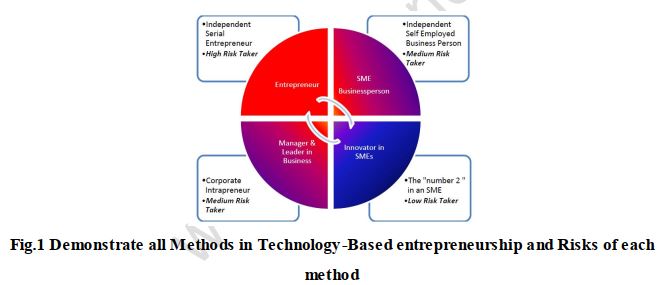A SURVEY STUDY ON AGE, EDUCATION AND PROFIT ROLE ON TECHNOLOGY-BASED ENTREPRENEURSHIP IN IRAN (CASE STUDY: FORTY SMALL AND MEDIUM TECHNOLOGY-BASED ENTREPRENEURSHIP UNITS)
Abstract
Much of the research into new firm formation focuses upon the entrepreneur and their characteristics or motivations or the external economic environment. This study revolves around the socio-economic structure of Technology-Based entrepreneurship in Iran and factors affecting the growth and development of enterprises and problems faced by them. For the purpose of data collection a sample of forty small and medium scale units was taken and a common schedule of structure questionnaire containing questions of various aspect of Technology-Based entrepreneurship was administered personally to the managing director of each of the units as the case may be. The research method in this study is basically exploratory and data collection is based on two methods, library and documents and questionnaires. The result shows that age is not a static phenomenon for Technology-Based entrepreneurship in Iran. Also the result shows peoples that have high education and more practical experience and training, enter into the industry early. Also, those who have less education but have more practical experience and training, enter into the industry slightly later than the previous. However, in such cases less education restricts the growth and development of the enterprise. The paper finds shows there are two reasons for Technology-Based enterpreneurship in Iran: earn high profits and prosperity. In the end, we have a number of suggestions for promoting Technology-Based entrepreneurship in Iran.
Downloads
References
Analoui Farhad, Mirza Hassan Hosseini, (2001) Management education and increased managerial effectiveness: The case of business managers in Iran, Journal of Management Development, Vol. 20 Iss: 9, pp.785 - 794 5
Alejandro Portes, Luis Eduardo Guarnizo and William J. Haller, (2002),Transnational Entrepreneurs: An Alternative Form of Immigrant Economic Adaptation, American Sociological Review, Vol. 67, No. 2, pp. 278-298.
Alain Verbeke, Liena Kano, (2013) The transaction cost economics (TCE) theory of trading favors, Asia Pacific Journal of Management, Volume 30, Issue 2, pp 409-431
Abdol S. Soofi, Sepehr Ghazinoory, (2013), Science and Innovations in Iran: Development, Progress, and Challenges, Palgrave Macmillan, 259 pages [6] Baumol, J (1993) Formal Entrepreneurship Theory in Economic: Existence and Bonds. Journal of Business Venturing 8, pp. 197-210
Bilal Ahmad Dar, Bhat Fayaz Ahmad, (2013), Small scale industries in Jammu and Kashmir (J & K): Growth, performance and challenges, International NGO Journal Vol. 8(2), pp. 38-43
Deshpande, M.U (1984), Entrepreneurship of Small Scale Industries, Deep and Deep Publication, New Delhi, Pp 49.
Drucker Peter F. (1985) Innovation and Entrepreneurship Heinemann, London, Pp. 20.
Dorothy, McCormick, (2013), why small firms stay small: risk and growth in Nairobi's small - scale manufacturing, Working paper no. 483, Nairobi: Institute for Development Studies, University of Nairobi.
Essien, O. E. (2001), “The Role of Development Finance Institutions in the Financing of Small Scale Industries” CBN Bullion. Vol. 25, No. 3.
Ehsan Rasoulinezhad, Farkhonde Jabalameli, (2103), Iran Solutions against the Economic Sanctions: Analytic Hierarchy Process Approach, American Journal of Business and Management, vol. 1, no. 1
Holiness, Scott (2001) “Definition of Small Business” Final Report of the Small Business Coalition (SBC) Australia, April 5.
Ilpo, A., M. Passi and N. Mikko (2004). Intergenerational Transmission of Poverty in Finland in the 1990s. University of Turkey, Department of social Policy Series C: 13.
M Hosseinzadeh, SM Vesal, R Shamsaddini, (2013), Prioritizing Competitive Strategies in Iranian SME's Based on AHP Approach in Severe Economic Sanctions, International Journal of Business and Management, vo. 8, no. 16
Murthy, N. (1989a) Entrepreneurship in Small Towns, In Samuddin (ed) Entrepreneurship Development in India, Mittal Publication, Delhi Pp4.
Pacific Economic Co-operation Council (PECC), (2003) Financing Small and Medium Enterprises. Challenges and Options, Singapore, PECC International Secretariat.
Ravindra Tripathi, Rajesh Kumar Shastri, Sweta Agarwal, (2013), Survival and Growth Strategies for Small- and Medium-Scale Enterprises in India: A Key for Sustainable Development, Driving the Economy through Innovation and Entrepreneurship journal, pp 163- 174
Say, J. B. (1994) A Treatise of Political Economy or the Production, Distribution and Consumption of Wealth Timmons, Jeffry (1999), New Ventures Creation, Entrepreneurship in the 21st Century. Irwin McGraw-Hill, Pages 27-30
Schumpeter, J. A. (1934): The Theory of Economic Development. Harvard University Press. Cambridge. M. A.
Schumpeter, J. A. (1959): The Theory of Economic Development. Harvard University Press, Cambridge, Massachusetts.
Stenholm.p, Zoltan J. Acs, Robert Wuebker, (2013), Exploring country-level institutional arrangements on the rate and type of entrepreneurial activity, Journal of Business Venturing, Volume 28, Issue 1, Pages 176–193
World Bank Survey (2012) Asian Region‟s Regional Programme on Entreprise Development (RPED)















